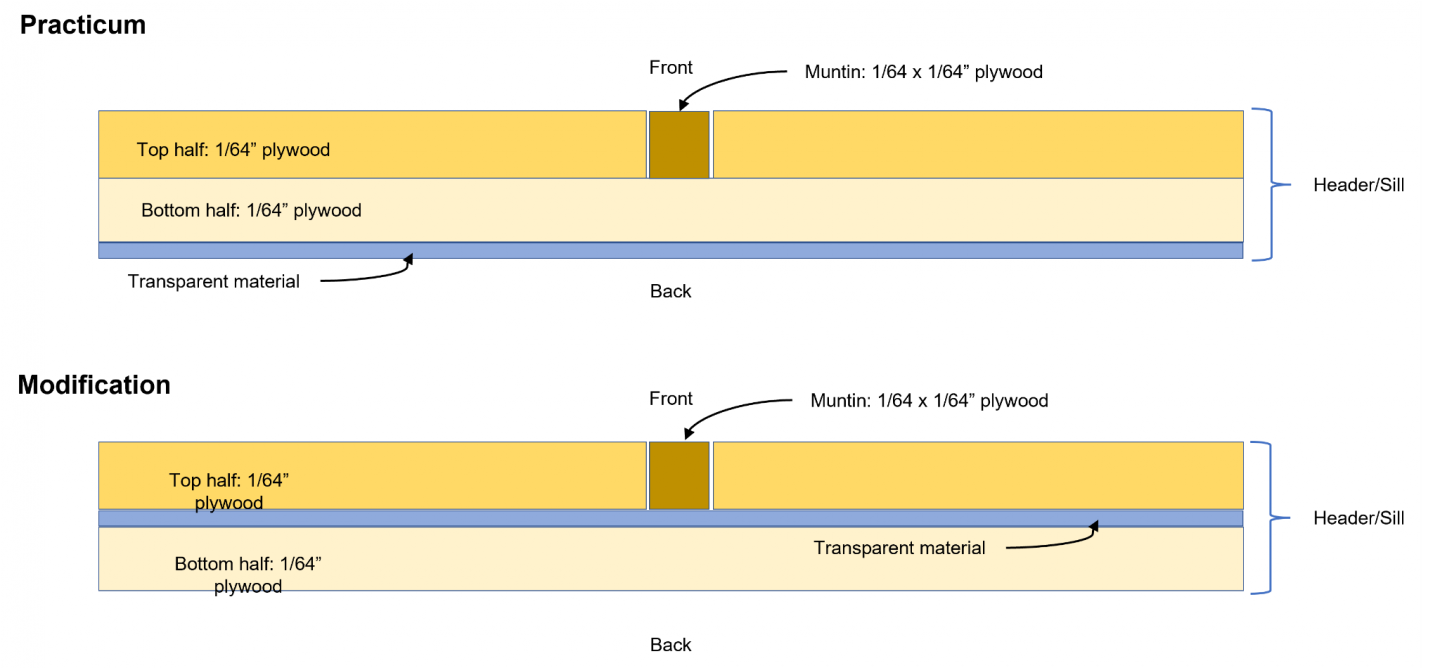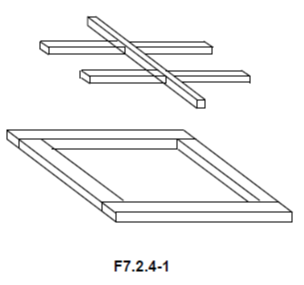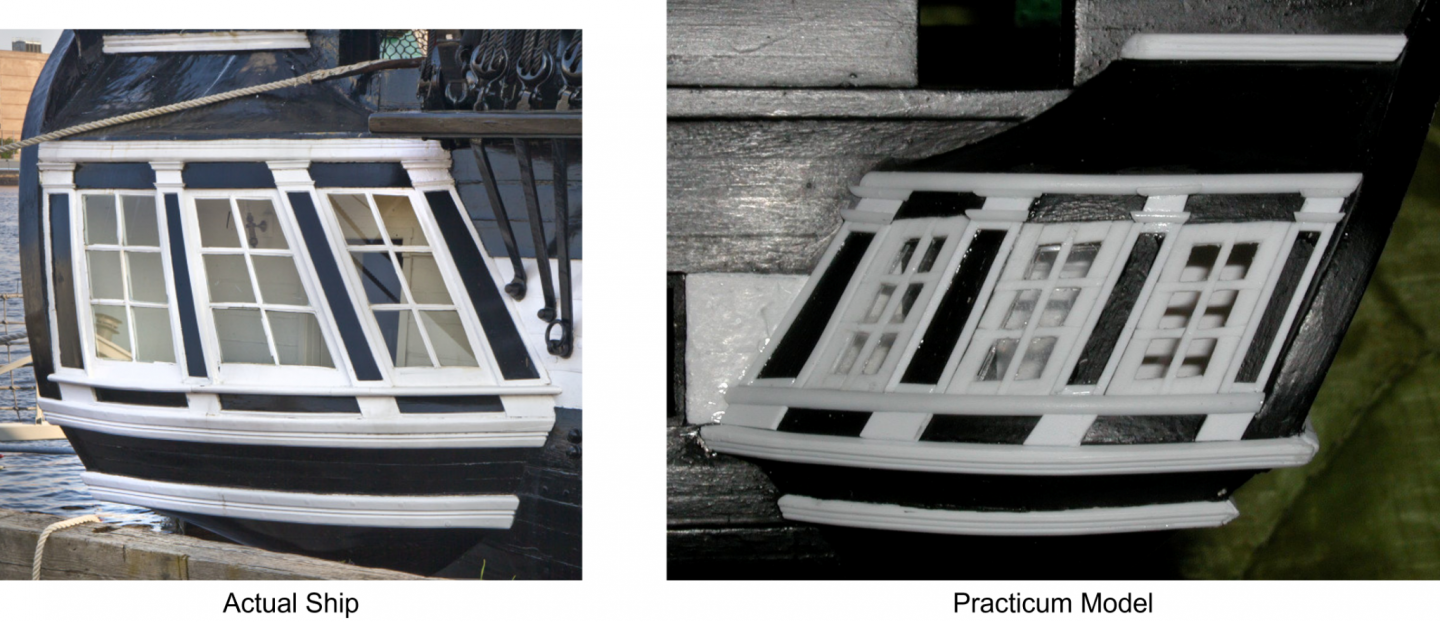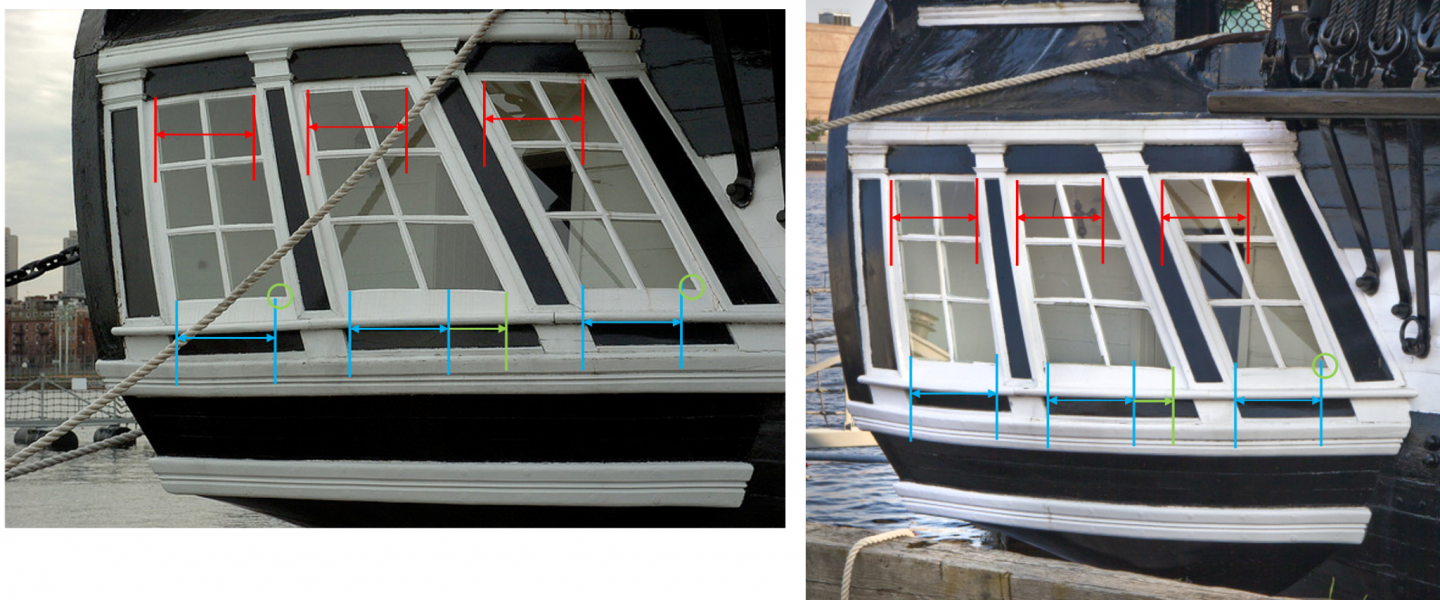-
Posts
2,611 -
Joined
-
Last visited
Content Type
Profiles
Forums
Gallery
Events
Everything posted by JSGerson
-
The more I looked at the sash, the more I didn’t like it. So, I started over and made a fourth attempt, using the same method as the third, and although not perfect, the results were more acceptable. So much so, I’ve started on the next sash. The picture below shows the dry fit of the painted, sans mica, fourth attempt as well as my progress on the second sash. The close-up shows waaaaay more flaws than a normal viewing would reveal. Luckily, most people will not see them. The next few days is the week before Thanksgiving, I’ll be preparing my visit to my Sister’s home for the holiday, my bathroom renovation continues, and ophthalmologist notified that I still need some minor surgery on my eyes. The surgery is out-patient, and hopefully won’t hinder me too much on my model. So, if my lightning building pace slows down a bit, I hope you followers will understand.
-
The front surface of the frame and all but the back surfaces of the muntins were painted white. Once dry, the frame was flipped over, and a piece of mica was place inside the back of the sash and secured with four dabs of Wellbond at the interior frame corners. The results, to my eyes, were acceptable but not the great. I attribute that to my building skills, not to the method. Although the window fit, the horizontal muntins should have been more parallel with the base of the window opening. I will see how the next window goes. I may go back and do this first window a fourth time.
-
Once the frame was formed and solid, any voids in the frame were filled in (sorry for out of focus image). Next came the window muntins. Using my fine hand miter saw, grooves were cut into the frame, one vertical and two horizontals about 1/64” deep. Because the grooves provide a solid gluing surface, the 1/64” square horizontal muntins met at the vertical muntin and touched. No support at this point was needed. The excess material was removed, and the surfaces sanded very carefully.
-
The first corner (in this case the lower left in the image) was glued together with a very small dab of Weldbond glue at the joint. This allowed for final adjustment. Before the joint cured, CA glue was used to get glue into the joint seams. The other three window joints were glued in the same method. The sash was NOT glued to the window opening at this time. Scrap wood was jury-rigged to provide a backing to prevent the pieces from falling into the model.
-
Well, I finally got some work done in between maintaining an eye on my bathroom renovation. Over a dozen people have come in and out of my home and its not over yet. Plan C worked…mostly. To create an accurate window frame, I measured directly from the model’s window opening, skipping making a template. Boxwood stock was place along the window opening and cut and trimmed to fit. Once the four sides pieces were made, a lap joint was made using the Byrnes saw.
-
Well, Plan B failed. I did what I intended, built the sash in reverse and it was easier as I had hoped, but like Plan A, not practical nor accurate. This time the problem was removing the partially constructed sash from the tape without breaking it. I thought I would be able to paint it before the mica was attached and secured with a backing bringing the total thickness to about 1/32”, but when I checked to see if it even fit properly in the window opening, well you can see what I saw in the image below. I hadn’t even cleaned it up, no point. I believe the basic problem is that the component is so small and delicate, any error compounds and magnifies any distortion. I still have at least Plans C (another method), D (jacknastyface2 method*) and E (Practicum’s method). So, its off to Plan C where I will forgo using a template and get my sash shape directly from the window opening. Stay tuned to the next installment of “Crash & Burn or Possibly Survive.” * jacknastyface2 is a fellow model builder on another site
-
Finally, I was able to get everything glued together. Peeling the completed sash from the tape was a delicate maneuver which didn’t go as smoothly as I would have liked it. The mica surface lifter off the inner frame which had to be glued back down…again.; some sash pieces had to be reglued into place. Finally, I was able to trim the excess and smooth the edges. I had a complete window sash with just one minor problem…It didn’t come close to fitting the window opening. Somehow through all the machinations of gluing, parts coming apart, re-gluing, etc. the vertical angle of the side of the sash changed. But I proved the concept through trial and lots of errors. To make things slightly easier (not simpler), my next attempt will attempt to build the window sash from the outside, inward as opposed to the way this one was made, inside outward. All 15 pieces of the outside sash component will be placed on the tape first and glued all at once, then the mica, and finally the four larger pieces of the inside sash. Hopefully this will work better, go faster, and everything will be cleaner, neater, and remain glued together.
-
It was at this point; I saw the major flaw in my modified cunning plan. I didn’t have a sticky surface anymore to hold the remaining 16 pieces to complete the sash. Everything now had to be glued to the slippery mica. Mica is very smooth and CA glue needed something to grip to. Even worse than that, because the sash pieces were very short, thin, and narrow, they tended to jump from the surface of the mica to my CA needle applicator due to surface tension of the liquid CA. Needless to say, there were numerous “do overs.” I should also point out that all the pieces had to be pre-painted while still a stock of wood, then cut to size.
-
Following my plan, by laying down the inside frame pieces on the template which was fastened down with double sided tape once again. These were glued together at the joints with CA glue. I tried to only paint white the inside surfaces of the muntins. I wanted the gluing surfaces bare wood. I tried sanding off the excess. It looks worse in the photos.
-
It’s been about 10 days and I am still working on the first sash, and it’s been a b*tch of an effort. I contemplated what material to use for the “glass” panes. Some years ago, I spoke with the master builder, David Antscherl at one of the NRG yearly conventions. He’s also authored numerous ship modeling books. I was admiring one of his models he had on display and asked what material he used for his windows. He replied that he used mica. A friend of his had giving him a large quantity of mica scraps which David said would last him a lifetime. Well, here was my opportunity to try that out, Not having a friend with excess mica to dispose of, I found what I needed on www.etsy.com for a reasonable price. When I received the package, the mica was all that I hoped it would be, free of defects, crystal clear, and very thin.
-
Because Mr. Hunt used styrene, he didn’t have to think about paint. I knew that I had to paint the sash before the last step installing a transparent material (not determined yet) for the windowpanes. Additionally, I noted that Mr. Hunt’s windows had a gap between the muntins and acetate he used for the panes. When he finished constructing his sash, he’d flip it over and applied the acetate to the inside surface of the window border. Therefore, his muntins were 1/64” above the acetate. This required that I modify his method slightly. As shown below, the modification would require that the transparent material be sandwiched between bottom and top elements of the window border pieces. This would also increase the gluing surface for the muntin installation thus increasing the structural integrity of the window sash… Or so goes the theory. Next immediate steps: remove the vertical muntin, remove any excess glue, smooth the surface, and paint the outside border of the partial sash white.
-
The sill, header and styles were laid down on the tape which held them fast. Next came the vertical muntin which was laid down very carefully into position. Most of the pieces were made a bit long so they could be handled easier. The excess would be filed off later. A few fine drops of CA glue at the joints and everything was what it should be…or not. Here is where my cunning plan started to fall apart.
-
The first thing the practicum tells you to do is make a template for each window opening, which I did. It then has you double side tape the template to a piece of card stock, which I did…wrong. I laid down the tape on the card stock and then stuck the template on the tape, so it was card stock tape, then template. That left the template without a sticky top surface, which was the whole point of the double-sided tape. Got it right on the second attempt.
-
For the sashes I am using 1/64” birch plywood for its strength. My second choice would have been boxwood, Since the final product will be painted white, no one will know what kind of material was used. The sill will use 1/16” x 1/64” plywood. The stiles and header will be 1/32” x 1/64” plywood. And the muntin (sash bars) will be 1/64” x 1/64” plywood. All of these strips of plywood will be cut from a 1/64” birch plywood sheet using the Byrne’s saw. The plan is to follow the practicum’s method of construction…for the most part.
-
The Quarter Gallery Window Sashes For the skill level of builders Mr. Hunt was aiming his practicum at, he chose throughout his practicum, to make certain tasks easier, but being the masochistic model builder that I am, I’ve chosen to take the path less traveled…again. Instead of using styrene strips indicated in the practicum to fabricate the sashes, I decided to stick with wood. Because he chose styrene strips, he had to use the strip sizes available to him, which in my humble opinion, were too large for the scale of the model as one can see in the comparison below. The header and window stiles (side frames) are much wider than what is shown in the actual photograph. Additionally, the sills on the actual ship appear twice as wide as the stiles and header. Don’t get me wrong, without a side-by-side comparison I would be very satisfied if my model looked anything like Mr. Hunt’s. But I do have a side-by-side comparison sooooo… I’m going to try to get my window sashes as close to looking like the real ship as I can.
-
Based on the template, the vertical window posts were added to the outside edges of the galleries. Then using the template marks I made on the sill and header as a guide, the two inner posts were added. Where there were some minor gaps, filler was used. Once everything was sanded, per the practicum three coats of polyurethane were applied and sanded. Finally, a couple of coats of black hull paint
-
I did a little more digging through my photo library and came to realize that the line trim on the real ship are not two separate strips but one wide piece with a groove down the middle. The area down the middle is actual proud of the hull, but not as high as the white trim. The white paint is indeed painted just on the surface (just as you plan to do) unlike the detail on the trailboard which is painted white down to the flat surface. I don't think any model builder I've seen, has actually constructed the trim on the model like the real ship. It's a detail that is lost in the scale of the model. I look forward to seeing your progress.
-
I didn't realize the trailboard wasn't glued in place. But still, painting the trim strips white with a black background might have been easier had the stem been painted black first. I mentioned in an earlier post that I thought you were using a too large tooth saw blade on your Byrne's saw for the cuts you were making and suggested you switch to a finer blade. The fine tooth blade will slice those 1/32" x 1/32" strips with ease, but first you need to make a zero tolerance plate for the saw. Jim sells blank plates just for that purpose. I've made 1/128" cuts without any problem, just maybe not 1/128" x 1/128". I've been working at the opposite end of the model, the quarter galleries which has challenges of it own. Before you start tackling that, take a look at my planning, it might save you some headaches. I concluded that you should NOT use the kit provided windows.
-
Very nicely done. Even though the practicum used styrene plastic for the trim, I too plan on using wood. I hope mine looks as perfect as yours. One thought though, would it not have been easier to have painted the trailboard first, then glued on the white trim? It looks like a real pain to paint it now.
-
While I was fiddling with the headers and sills, I kept looking at images of the quarter galleries trying picture in my mind their true shapes. Using images that were taken at an angle to show their proper shapes better, I noticed something about their dimensions. All three of windows have the same width for their header (as measured from the glass panes). The vertical elements of course are at different angles. The sills of the outer windows are very close to being the same width, but not quite. The center window sill is approximately a half to two thirds of a pane of glass wider. I checked this on two separate images with the same results In the picture below, the red dimensions are all the same as each other as are the blue ones per photograph. The green dimension indicates dimensional differences. The kit supplied windows do not even come close to these proportions. Now I have an idea as what my model windows should emulate.
About us
Modelshipworld - Advancing Ship Modeling through Research
SSL Secured
Your security is important for us so this Website is SSL-Secured
NRG Mailing Address
Nautical Research Guild
237 South Lincoln Street
Westmont IL, 60559-1917
Model Ship World ® and the MSW logo are Registered Trademarks, and belong to the Nautical Research Guild (United States Patent and Trademark Office: No. 6,929,264 & No. 6,929,274, registered Dec. 20, 2022)
Helpful Links
About the NRG
If you enjoy building ship models that are historically accurate as well as beautiful, then The Nautical Research Guild (NRG) is just right for you.
The Guild is a non-profit educational organization whose mission is to “Advance Ship Modeling Through Research”. We provide support to our members in their efforts to raise the quality of their model ships.
The Nautical Research Guild has published our world-renowned quarterly magazine, The Nautical Research Journal, since 1955. The pages of the Journal are full of articles by accomplished ship modelers who show you how they create those exquisite details on their models, and by maritime historians who show you the correct details to build. The Journal is available in both print and digital editions. Go to the NRG web site (www.thenrg.org) to download a complimentary digital copy of the Journal. The NRG also publishes plan sets, books and compilations of back issues of the Journal and the former Ships in Scale and Model Ship Builder magazines.








